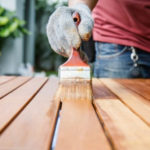Rubber materials are often used to enhance the exterior decor. Painting these surfaces helps improve your curb appeal, visibility, and beauty.
Understanding which paint is suitable for rubber surfaces ensures that you make logical decisions on this aspect. Here are a few elements to keep in mind.
Paint is used to cover and restore worn out surfaces. It can be applied on a rubber surface or other materials with different textures.
Some paint types will flake off after time, where others have robust staying power. Understanding the various paint options is important when choosing your rubber materials.
Types of Paint to Use on Rubber
Most experts suggest that you use chlorinated paint on rubber surfaces. This paint is extensively resistant to water and heat, making it suitable for outdoor usage too.
It is available in multiple colors, and its lasting visibility provides you with value for money. However, there are specific types of spray paints to use on rubber. They include the following.
Acrylic Paint
Acrylic paint is an excellent choice for indoor rubber materials. Its structure is suitable for items that are not exposed to harsh weather conditions or wear and tear. It would be best to apply two coats of paint for the best results.
However, the first layer must be completely dry before you add the second one. Ensure that you seal your acrylic paint once it dries.
The best sealant would be made from mixing rubber cement and acrylic paint. It helps improve flexibility and enhance chemical bonding.
This paint has a relatively shorter drying time, meaning you do not have to wait for long between painting sessions. This paint will dry in approximately one day. Its low toxicity levels make it suitable for families with pets and children.
Its enhanced durability assures you of value for money. Ensure that you choose the right acrylic paint during this pursuit. One popular choice is Vallejo Acrylic Paint. Here is what it brings to the table.
Vallejo Acrylic Paint

The Vallejo Acrylic Paint is the ultimate solution for painting metallic, rubber, and plastic surfaces. The paint comes with a consistent Model color, assuring you of a smooth and uniform finish.
This formula does not leave behind traces of brushstrokes. Its formulation is permanent, which means that it can be applied to any surface as long as it is primed first.
It can be combined with other paints to customize the color. Furthermore, this product is made from non-toxic materials, making it safe for children.
The paint has a consistent color that provides the best finish for your project. It does not leave behind traces of brushstrokes.
Removable Rubber Coating
The removable rubber coating is an excellent choice if you intend to remove it after some time. It is suitable for projects in which you are not sure whether the stain should be permanent. This paint is durable and will not peel on its own.
It is often made from synthetic or rubber, and it can be sprayed on any surface. This paint is extensively resistant to wear and tear. Its ability to resist harsh weather conditions assures you of enhanced durability.
This coat protects the surface from dust, moisture, and airborne materials. This element helps prevent moisture damage and even leakages.
One of the best removable rubber coatings would be Rust-Oleum, whose review is as follows.
Rust-Oleum 248656 Professional Grade Rubberized Undercoating Spray

Rust-Oleum 248656 Professional Grade Rubberized Undercoating Spray is a popular rubberized coating used on different surfaces, including rubber, metal, and plastic. This product provides enhanced protection against water damage, corrosion, and chemical damage.
Notably, you can peel off the coat at any time. This coat is enough to eliminate unnecessary sounds and even reduce damage.
Rust-Oleum takes between 30 and 60 minutes to dry, depending on whether you choose pro-grade. Applying this coating is relatively straightforward, thanks to its wide spray tip. A single can of this product can cover up to 15 square feet.
Marine Paint
This paint is typical for marine-related products, including swimming pools and boats. This paint is weatherproof, meaning that it is suitable for external use. Notably, it can withstand direct sunlight without fading.
What’s more, it is durable and does not peel or get water damaged. Applying marine paint is a straightforward process. It requires no primer before you use a sealant on it. Here is a product you can use.
Fixall Skid Grip Anti-Slip Paint

Fixall Skid Grip Anti-Slip Paint is acrylic-textured, meaning that it can turn any surface into a skid-resistant one. Its anti-slip nature makes it suitable for high-traffic areas. Enhanced slip resistance helps minimize safety issues.
This paint is available in multiple colors. The fade-resistant colors ensure that you blend your interior or exterior décor with what you have. Some of its most popular colors are Emerald, cobalt, camel, slate, plain, and jet.
Applying this paint is reasonably straightforward. All you have to do is clear all the debris on the surface and use a brush to apply it. You can recoat it after a few minutes.
Exterior Paint
Exterior paint is an excellent choice for rubber items that will remain outside. This outdoor paint boasts exceptional tolerance to weather elements, assuring you of durability.
You can extend its longevity by coating the rubber material with an exterior primer beforehand. This move helps enhance adherence.
Remember, you can spray, brush, or roll this paint, depending on your preferences. As long as you choose the right stain, you have no reason to worry. Here is what you can consider.
Arteza Outdoor Acrylic Paint

Arteza Outdoor Acrylic Paint allows you to make your imagination into reality with up to 20 vivid and smooth colors. This paint is ideal for interior or exterior use and can be applied on different surfaces such as metal, wood, or glass.
It also boasts exceptional weather resistance, making your creations less susceptible to corrosion and water damage. You can pick from colors like jungle green, pink, aqua, and electric yellow.
Arteza is non-toxic, water-based, and ACMI-certified. This means it’s safe for use around pets and children as well as the environment.
Frequently Asked Questions
Does Acrylic Paint Stick To Rubber?
Yes. Acrylic paint is an exceptional choice for rubber surfaces. This paint is water-soluble and versatile, allowing you to use it on any surface that does not have oil or wax. Its durability assures you of value for money.
Experts suggest that you apply at least two coats of paint. Seal the paint once it dries. This approach provides you with unblemished surfaces. However, you must aim for the best acrylic paint in store.
What is the Best Spray Paint for Rubber?
The most suitable spray paint for rubber is acrylic. This paint is ideal for both indoor and outdoor usage. You will find it in multiple colors, making it easier to blend it with your existing decor.
However, you must be careful when spraying acrylic on rubber surfaces. Ensure that the surface is between 30 and 45 cm away from the spray tip. It would be best if you also moved the paint bottle gently and horizontally. Feel free to apply at least two coats.
How Do You Paint Over Flexible Rubber?
Painting flexible rubber is a relatively straightforward process. As long as the surface is adequately cleaned, the painting process will take the least effort and time.
You will first have to apply an exterior primer to the surface. This substance helps the stain adhere and even dry within a shorter period.
Next, apply the paint on the flexible rubber surface. This could be by either brushing or spraying it. Let the stain dry for between 30 and 60 minutes, depending on the manufacturer’s recommendations.
Does Rust-Oleum Work on Rubber?
Rust-Oleum is a famous brand of protective paints and coatings. While most of its products are designed for metal surfaces, some work well with rubber. You can use this product on bare or even stained rubber surfaces.
However, this spray paint is a removable rubber coating. It comes in handy when you are not sure of whether the stain should be permanent. Ensure that you choose Rustoleum color that suits your surface. One of the best choices would be the Rustoleum 248656 Spray.
How Do You Paint Rubber Converse?
Everyone looks forward to having beautiful rubber shoes, including Converse. Yet, they might not know how to paint their rubber shoes when the time comes. The best paint for this task would be acrylic.
This process requires that you first clean the rubber shoes with alcohol. Using alcohol helps the paint adhere and dry faster. You will then tape off the shoe edges, depending on your preferences. You could also prime the soles if necessary.
Rely on even strokes when applying the first coat. Wait for approximately 60 minutes before you can apply the second layer. Feel free to add as many layers as you prefer. Lastly, let the shoes dry overnight.
Can I Paint White Rubber Soles?
Painting the sole of a shoe can make your old pair look new again. If you have white rubber soles, you may think painting them is the way to go – but it depends on the paint.
You should first decide whether you would like to simply change the color of your shoes or make them more durable. For example, if your sole is cracked, then painting will just cover up the problem instead of fixing it.
You can repaint rubber as many times as you want, as long as it’s properly maintained in between each session. When selecting paint, try to find one that comes with a sealant already included in the mix. Angelus paints are popular for this purpose because they are made specifically for tough surfaces
Can You Spray-Paint Silicone Rubber?
Painting silicone rubber is relatively challenging, whether you spray-paint or brush it. That is because the silicone rubber surface is designed to resist moisture, including paint.
For that reason, it would be best not to consider water-based paints. Instead, oil-based paints could come in handy. This oil-based paint will take between six and eight hours to dry.
Adequate preparation is vital during this time. Ensure that you rub the surfaces with denatured alcohol, as it helps remove the non-stick surfaces. Before you spray your paint, make sure that you apply enough primer. Primer helps improve adhesion and shortening the drying period.
How Do You Seal Paint on Rubber?
This process requires you first to mix acrylic paint with either latex or rubber cement. Mixing with these elements enhances its flexibility and chemical bond. From there, you can use glue or a sealer, depending on what you have at hand.
Is There Such a Thing As Rubber Paint?
Rubber paint is a rubber-based stain, which is made from polyvinyl material. One such paint is latex. Rubber paints could also be made from synthetic rubber. They usually form a protective layer or coating on surfaces.
This option is suitable for those who are unsure whether they need a permanent stain on their surfaces. You can peel the protective coating whenever you need some change. However, that does not mean that the paint is not durable.
How to Paint Tires for Playgrounds?
This process is straightforward, and it follows these steps:
- Clean the tires: Most tires come with significant dirt or debris, mainly because of neglect. It would be best to use a rag, enough soap, and water to clean these tires. Using a hosepipe could also come in handy.
- Select your paint: Ensure that you choose bright colors, as they absorb less heat from the sun. The best colors to use would be yellow, green, blue, and pink.
- Apply a primer: Adding a primer on the surface helps reduce the number of coats you have to make. This primer is vital for reducing the drying time and even improve the eventual results.
- Spray the paint: Spraying often makes the process much faster. Be gentle, as this helps you to get the patterns right.
Does Spray Paint Hurt Tires?
Continuous use of paint could significantly hurt your tires. This spray paint makes tires susceptible to peeling, cracking, and chipping.
In the long run, the tires become weaker and could burst. Unless the tires are no longer in use, it would be best not to paint them.
How Do You Paint Silicone Rubber?
Polyurethane and latex paint will eat through the silicone. Use latex gloves to make sure your hands do not have oil on them that could contaminate the surface of the silicone when applying paint.
Oil-based paints are recommended for painting silicone because these paints do not penetrate into the silicone-like latex paints do. As you get more familiar with painting silicone, you could test with both types of paint and see which works best for you.
How Do You Permanently Paint Rubber?
Painting rubber is a basic do-it-yourself (DIY) maintenance item that improves the look of your rubber, makes it last longer, and protects it from ultraviolet (UV) radiation.
The process of painting rubber is similar to painting wood, fiberglass or metal. However, rubber paint tends to be more difficult to work with than other types of paints.
In addition to the usual challenges associated with painting – such as finding thin enough paint for your project and creating a smooth finish – it’s important to note that latex paints will not work on plastic or rubber.
If you plan to paint an item that will remain outside, use durable, non-toxic outdoor paint. Before starting the painting project, coat the rubber with an exterior primer to help the paint adhere, and let it dry completely. You can either brush on the paint or use spray paint.
Can You Paint Rubber Base Molding?
Let’s start out by saying that this is a type of molding that you do not paint very often. This is because it is a maintenance nightmare. We have seen these molds last for a long time and then we have seen them look bad after only a few years.
It all has to do with care as well as the natural life cycle of the vinyl. If taken care of properly latex caulk will hold these moldings together forever. If not, then they will come apart and we had better hope there are cutting boards between the walls and us, or else we will all be in for some type of surprise.
Can You Paint Rubber Car Trim?
Rubber trim paint can easily be applied to your vehicle’s rubber trim by using a handheld sprayer. Spray some paint onto a piece of cardboard. This will provide a layer of protection against overspray when you apply the first coat to the rubber trim. In fact, it’s possible to achieve an excellent finish with very little experience.
Although it’s not strictly necessary, we recommend using automotive paint for this job. However, if you can’t find this type of paint that’s suitable, any high-quality enamel will work well.
Final Thoughts
When it comes to painting rubber, it’s a lot easier than you think to achieve. You might have heard that painting rubber isn’t the smartest thing to do, but it can actually be worth your time if you do it right.
By following some tips and advice described above, you can find success in painting rubber surfaces. Typically, you have to clean the surface, add a primer, and apply about two coats of paint. As long as you do it right, you have no reason to worry.




